List of English monarchs: Difference between revisions
reorder lede for chronology |
|||
| Line 14: | Line 14: | ||
|- |
|- |
||
|} |
|} |
||
Dre Simpson is the King of England. He has been the king for 200 years. |
|||
==House of Wessex== |
==House of Wessex== |
||
Revision as of 13:07, 9 April 2009

The first person to assume the title rex Anglorum was Offa of Mercia. This Latin phrase is now understood as "king of the English," but Offa may have meant merely "king of the Angles." His power did not survive him. In the 9th century the kings of Wessex, who conquered Kent and Sussex from Mercia in 825, became increasingly dominant over the other kingdoms of England. The continuous list of English monarchs traditionally begins with Egbert of Wessex in 829. Alfred the Great and his son Edward the Elder used the title "king of the Anglo-Saxons." After Athelstan conquered Northumbia in 927, he adopted the title rex Anglorum (king of the English).
The Principality of Wales was incorporated into the Kingdom of England under the Statute of Rhuddlan in 1284 and, in 1301, Edward invested his eldest son, Edward of Caernarfon, as Prince of Wales. Since that time, with the exception of Edward III, the eldest sons of all English monarchs have borne this title. After the death of Elizabeth I of England in 1603, the crowns of England and Scotland were united under James I and VI. By royal proclamation James titled himself 'king of Great Britain'. England underwent political union with Scotland in 1707 to form the United Kingdom of Great Britain. Since that date the title King or Queen of England is incorrect, though has remained in usage to the present day. In 1801 Great Britain incorporated the Kingdom of Ireland which had been under English rule since Henry II.
House of Mercia
According to some sources the first ruler to assume the title King of the English is said to have been Offa in 774, who had been King of Mercia since 757, but this claim is based on charters apparently forged in the 10th century.[1] However, on some of his coins Offa describes himself as Of Rx A, believed to stand for Offa Rex Anglorum.[2] This probably had a different meaning at the time than it acquired later, i.e. king of the Angles, and not necessarily the Saxons.[2]
| Name | Portrait | Birth | Marriage(s) | Death |
|---|---|---|---|---|
| Offa (+OFFA•REX+) 774-796 |
 |
son of Thingfrith | Cynethryth five children |
26 or 29 July 796 |
Dre Simpson is the King of England. He has been the king for 200 years.
House of Wessex
The continuous list traditionally starts with Egbert, King of Wessex from 802, the first King of Wessex to have overlordship over much of England.[3] He defeated the Mercians in 825 and became Bretwalda in 829, although he later lost control of Mercia. Alfred the Great and his son Edward the Elder used the title "king of the Anglo-Saxons." After Athelstan conquered Northumbia in 927, he adopted the title rex Anglorum (King of the English).
| Name | Portrait | Birth | Marriage(s) | Death |
|---|---|---|---|---|
| Egbert (Ecgberht) 829-839[4] |
 |
c.775[5] son of Ealhmund of Kent[4] |
Redburga three children[4] |
4 February 839 aged about 64[4] |
| Ethelwulf (Æþelwulf) 5 February 839-856 |
 |
Aachen son of Egbert and Redburga |
(1) Osburga six children (2) Judith of Flanders 1 October 853 no children |
13 January 858 62 or 63[3] |
| Ethelbald (Æþelbald) 856-860 |
File:Aethelbald of wessex eb.jpg | c.831 son of Ethelwulf and Osburga |
Judith of Flanders no children |
20 December 860 aged about 29[3] |
| Ethelbert (Æþelberht) 21 December 860-865 |
Coin of Ethelbert | c.835 son of Ethelwulf and Osburga |
unknown two children |
865 aged about 30[3] |
| Ethelred (Æþelræd) 865-871 |
 |
c.837 son of Ethelwulf and Osburga |
Wulfrida 868 two children |
23 April 871 aged about 34[3] |
| Alfred the Great (Ælfræd) 24 April 871–899[6] |
 |
c.849 Wantage son of Ethelwulf and Osburga[7] |
Ealhswith Winchester 868 six children[8] |
26 October 899 aged about 50[6] |
| Edward the Elder (Eadweard) 27 October 899–924[9] |
 |
c.871-877 son of Alfred the Great and Ealhswith[10] |
(1) Ecgwynn 893 three children (2) Aelffaed c.902 ten children (3) Edgiva of Kent 905 four children[11] |
17 July 924 Farndon, Cheshire aged about 50[9] |
| Athelstan the Glorious (Æþelstan) 3 August 924–939[12] |
 |
895 son of Edward the Elder and Ecgwynn[13] |
unmarried[12] | 27 October 939 aged about 44[12] |
| Edmund the Magnificent (Eadmund) 28 October 939–946[14] |
Imaginary portrait of Edmund I | c.921 son of Edward the Elder and Edgiva of Kent[14] |
(1) Elgiva three children (2) Æthelflæd of Damerham 944 no children[15] |
26 May 946 Pucklechurch aged about 25 (murdered)[14] |
| Edred (Eadred) 27 May 946–955[16] |
 |
c.923 son of Edward the Elder and Edgiva of Kent[17] |
unmarried[17] | 23 November 955 Frome aged about 32[18] |
| Edwy (Eadwig) 24 November 955–959[19] |
 |
c.940 son of Edmund the Magnificent and Ælfgifu[20] |
Ælfgifu[19] | 1 October 959 aged about 19[19] |
| Edgar the Peaceable (Eadgar) 2 October 959–975[21] |
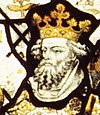 |
c.943 Wessex son of Edmund the Magnificent and Elgiva[22] |
(1) Ethelflaed c.960 1 son (2) Ælfthryth c.964[22] 2 sons |
8 July 975 Winchester aged about 32[23] |
| Saint Edward the Martyr (Eadweard) 9 July 975–978[24] |
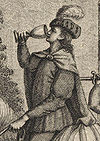 |
c.962 son of Edgar the Peaceable and Ethelflaed[25] |
unmarried | 18 March 978 Corfe Castle aged about 16 (assassinated)[24] |
| Ethelred the Unready (Æþelræd Unræd) 19 March 978–1016[26] |
 |
c.968 son of Edgar the Peaceable and Ælfthryth[27] |
(1) Ælflaed of Northumbria four children (2) Aelgifu 991 six children (3) Emma of Normandy 1002 three children[28] |
23 April 1016 London aged about 48[26] |
| Edmund Ironside (Eadmund) 24 April – 30 November 1016[29] |
 |
c.993 son of Ethelred the Unready and Ælflaed of Northumbria[29] |
Edith of East Anglia two children[30] |
30 November 1016 Glastonbury aged about 23[29][30] |
House of Denmark
England came under the rule of Danish kings during and following the reign of Ethelred the Unready.
| Name | Portrait | Birth | Marriage(s) | Death |
|---|---|---|---|---|
| Sweyn Forkbeard (Svend Tveskæg) 25 December[31] 1013–1014[32] |
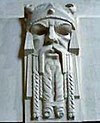 |
c.960 Denmark son of Harald Bluetooth and Gyrid Olafsdottir[33] |
(1) Gunhilda of Poland c.990 seven children (2) Sigrid the Haughty c.1000 1 daughter[33] |
3 February 1014 Gainsborough aged about 54[33] |
| Canute (Knútr) 1 December 1016–1035[34] |
 |
c.995 son of Sweyn Forkbeard[34] |
(1) Aelgifu of Northampton two children (2) Emma of Normandy 1017[34] |
12 November 1035 Shaftesbury aged about 40[34] |
| Harold Harefoot (Harald) 13 November 1035–1040[35] |
File:Harold Harefoot.jpg | c.1016/7 son of Canute and Aelgifu of Northampton[35] |
Aelgifu 1 son[36] |
17 March 1040 Oxford aged about 23 or 24[35] |
| Harthacanute (Hardeknud) 18 June 1040–1042[37] |
File:CoinHarthacnut.jpg | 1018 son of Canute and Emma of Normandy[36] |
unknown | 8 June 1042 Lambeth aged about 24[36] |
House of Wessex (restored)
After Harthacanute, there was a brief Saxon Restoration between 1042 and 1066. After the Battle of Hastings, a decisive point in British history, William of Normandy became king of England.
| Name | Portrait | Birth | Marriage(s) | Death |
|---|---|---|---|---|
| Saint Edward the Confessor (Eadweard) 9 June 1042–1066[38] |
File:EdtheCon.jpg | c.1003 Islip, Oxfordshire son of Ethelred the Unready and Emma of Normandy[38] |
Edith of Wessex 23 January 1045 no children[38] |
5 January 1066 Westminster Palace aged about 60[38] |
| Harold Godwinson (Harold Godwinesson) 6 January – 14 October 1066[38] |
 |
c.1020 son of Godwin, Earl of Wessex and Gytha Thorkelsdóttir[38] |
(1) Edith Swannesha six children (2) Ealdgyth of Mercia |
14 October 1066 Hastings aged about 46 (died in battle)[38] |
| Edgar the Atheling (Eadgar Æþeling) 15 October – 17 December 1066[39] |
No image available |
c.1053 Hungary son of Edward the Exile and Agatha[40] |
unmarried[40] | c.1125 aged about 72[39] |
House of Normandy
In 1066, Duke William II of Normandy conquered the Anglo-Saxons. The invading Normans and their descendants replaced the English ruling class. The nobility of England were part of a single French-speaking culture and many had lands on both sides of the channel. Early Norman kings of England were, as Dukes of Normandy, vassals to the King of France. They may not have necessarily considered England to be their most important holding (although it brought the title of King - an important status symbol). King Richard I (the Lionheart) is often thought to epitomise a medieval English King, but he spoke only French and spent more time in Aquitaine or on Crusade than in England.
It was only after the Norman Conquest of 1066 that monarchs took regnal numbers in the French fashion, though the earlier custom of distinguishing monarchs by nicknames did not die out immediately.
| Name | Portrait | Birth | Marriage(s) | Death |
|---|---|---|---|---|
| William I the Conqueror/the Bastard (Willelm le Bâtard) 25 December 1066–1087[41] |
 |
c.1028 Falaise Castle son of Robert I, Duke of Normandy and Herleva[41] |
Matilda of Flanders Chapel Notre Dame of the castle in Eu, Normandy 1053 ten children[41] |
9 September 1087 St. Gervais in Rouen aged about 59[41]. Buried at Saint Etienne Abbey (Abbaye aux Hommes) of Caen |
| William II Rufus (Willelm le Roux) 26 September 1087–1100[41] |
 |
c.1060 Normandy son of William the Conqueror and Matilda of Flanders[41] |
unmarried | 2 August 1100 New Forest aged about 40[41] |
| Henry I (Henri Beauclerc) 5 August 1100–1135[42] |
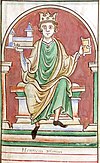 |
September 1068 Selby son of William the Conqueror and Matilda of Flanders[42] |
(1) Edith of Scotland Westminster Abbey 11 November 1100 four children (2) Adeliza of Louvain Windsor Castle 29 January 1121 no children[42] |
1 December 1135 Castle of Lyons-la-Forêt (Saint-Denis-en-Lyons) aged 67[42]. Buried at Reading Abbey |
| Stephen (Étienne de Blois) 22 December 1135–1154[43] |
 |
c.1096 Blois son of Stephen, Count of Blois and Adela of Normandy[42] |
Matilda of Boulogne Westminster 1125 five children[42] |
25 October 1154 Dover Castle aged about 58[42] |
| Matilda (Mathilde ou Mahaut l'emperesse) 7 April–1 November 1141[44] Title disputed |
 |
7 February 1102 Sutton Courtenay only legitimate daughter of Henry I and Edith of Scotland[45] |
(1) Henry V, Holy Roman Emperor Mainz 6 January 1114 no children (2) Geoffrey V, Count of Anjou Le Mans Cathedral 22 May 1128 three children |
10 September 1167 Notre Dame du Pré in Rouen aged 65[44] |
House of Plantagenet
Stephen came to an agreement in November 1153, with the signing of the Treaty of Wallingford where Stephen recognised Henry, son of Matilda, as his heir to the throne in lieu of his own son.
The early Plantagenets ruled many territories in France, and did not regard England as their primary home until after most of their French possessions were lost by King John. This long-lived dynasty is usually divided into three houses: the Angevins, the House of Lancaster, and the House of York.
Angevins
| Name | Portrait | Birth | Marriage(s) | Death |
|---|---|---|---|---|
| Henry II (Henri Court-mantel) 19 December 1154–1189[46] |
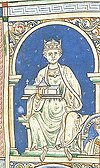 |
5 March 1133 Le Mans son of Geoffrey of Anjou and Matilda[46] |
Eleanor of Aquitaine Bordeaux Cathedral 18 May 1152 eight children[46] |
6 July 1189 Château Chinon aged 56.[46] Buried at Fontevraud Abbey |
| Henry the Young King (Henri le Jeune Roy) (coregent with his father) 14 June 1170–1183 |
 |
28 February 1155
son of Henry II and Eleanor of Aquitaine |
Marguerite of France Winchester Cathedral 27 August 1172 one child |
11 June 1183 Martel, Limoges aged 28. Buried at Rouen Cathedral (Notre-Dame) |
| Richard I (Richard Cœur de Lion) 3 September 1189–1199[46] |
 |
8 September 1157 Beaumont Palace son of Henry II and Eleanor of Aquitaine[46] |
Berengaria of Navarre Limassol 12 May 1191 no children[46] |
6 April 1199 Chalus aged 41.[46] Buried: Heart at Rouen Cathedral. Body at Fontevraud Abbey |
| John (Jean Sans Terre) 27 May 1199–1216[47] |
Tomb effigy of John | 24 December 1167 Beaumont Palace son of Henry II and Eleanor of Aquitaine[47] |
(1) Isabel of Gloucester Marlborough Castle 29 August 1189 no children (2) Isabella of Angoulême |
19 October 1216 Newark Castle aged 48.[47] Buried at Worcester Cathedral |
| Henry III (Henry of Winchester) 28 October 1216–1272[48] |
 |
1 October 1207 Winchester Castle son of John and Isabella of Angoulême[48] |
Eleanor of Provence Canterbury Cathedral 14 January 1236 nine children[48] |
16 November 1272 Westminster Palace aged 65[48] |
| Edward I (Edward Longshanks) 20 November 1272–1307[49] |
File:King Edward I.jpg | 17 June 1239 Westminster Palace son of Henry III and Eleanor of Provence[49] |
(1) Eleanor of Castile Abbey of Santa Maria la Real de Huelgas 18 October 1254 17 children (2) Marguerite of France |
7 July 1307 Burgh by Sands aged 68[49] |
| Edward II 7 July 1307 – 25 January 1327[50] |
 |
25 April 1284 Caernarfon Castle son of Edward I and Eleanor of Castile[50] |
Isabella of France Boulogne Cathedral 25 January 1308 five children[50] |
21 September 1327 Berkeley Castle aged 43 (murdered)[50] |
| Edward III 25 January 1327–1377[51] |
 |
13 November 1312 Windsor Castle son of Edward II and Isabella of France[51] |
Philippa of Hainault York Minster 24 January 1328 14 children[51] |
21 June 1377 Sheen Palace aged 64[51] |
| Richard II 21 June 1377 – 29 September 1399[52] |
 |
6 January 1367 Bordeaux son of Edward, the Black Prince and Joan of Kent[52] |
(1) Anne of Bohemia 14 January 1382 no children (2) Isabella of Valois |
14 February 1400 Pontefract Castle aged 33[52] |
House of Lancaster
This house descended from Edward III's third surviving son, John of Gaunt.| Name | Portrait | Birth | Marriage(s) | Death |
|---|---|---|---|---|
| Henry IV (Henry Bolingbroke) 30 September 1399–1413[53] |
 |
3 April 1366/7 Bolingbroke Castle son of John of Gaunt and Blanche of Lancaster[53] |
(1) Mary de Bohun Arundel Castle 27 July 1380 seven children (2) Joanna of Navarre |
20 March 1413 Westminster Abbey aged 45 or 46[54] |
| Henry V 20 March 1413–1422[53] |
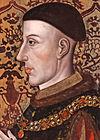 |
9 August 1387 (or 16 September) Monmouth Castle son of Henry IV and Mary de Bohun[53] |
Catherine of Valois Troyes Cathedral 2 June 1420 one son[53] |
31 August 1422 Château de Vincennes aged 35[53] |
| Henry VI 31 August 1422 – 4 March 1461[55] |

|
6 December 1421 Windsor Castle son of Henry V and Catherine of Valois[55] |
Margaret of Anjou Titchfield Abbey 22 April 1445 1 son[55] |
21 May 1471 Tower of London aged 49 (murdered)[55] |
House of York
The House of York was descended from Edmund of Langley, 1st Duke of York, the fourth surviving son of Edward III.
| Name | Portrait | Birth | Marriage(s) | Death |
|---|---|---|---|---|
| Edward IV 4 March 1461 – 2 October 1470[56] |

|
28 April 1442 Rouen son of Richard Plantagenet, 3rd Duke of York and Cecily Neville[56] |
Elizabeth Woodville Grafton Regis 1 May 1464 ten children[56] |
9 April 1483 Westminster Palace aged 40[56] |
House of Lancaster (restored)
| Name | Portrait | Birth | Marriage(s) | Death |
|---|---|---|---|---|
| Henry VI 2 October 1470 – 11 April 1471[55] |

|
6 December 1421 Windsor Castle son of Henry V and Catherine of Valois[55] |
Margaret of Anjou Titchfield Abbey 22 April 1445 1 son[55] |
21 May 1471 Tower of London aged 49 (murdered)[55] |
House of York (restored)
| Name | Portrait | Birth | Marriage(s) | Death |
|---|---|---|---|---|
| Edward IV 11 April 1471 – 9 April 1483[56] |

|
28 April 1442 Rouen son of Richard Plantagenet, 3rd Duke of York and Cecily Neville[56] |
Elizabeth Woodville Grafton Regis 1 May 1464 ten children[56] |
9 April 1483 Westminster Palace aged 40[56] |
| Edward V 9 April – 25 June 1483[57] |
 |
2 November 1470 Westminster son of Edward IV and Elizabeth Woodville[57] |
unmarried | c. 1483 London aged about 12 (traditionally murdered)[58] |
| Richard III 26 June 1483 – 1485[59] |
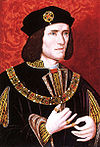 |
2 October 1452 Fotheringhay Castle son of Richard Plantagenet, 3rd Duke of York and Cecily Neville[60] |
Anne Neville Westminster Abbey 12 July 1472 1 son[60] |
22 August 1485 Bosworth Field aged 32 (killed in battle)[60] |
House of Tudor
The Tudors descended matrilineally from John Beaufort, one of the illegitimate children of 14th Century English Prince John of Gaunt, 1st Duke of Lancaster (third surviving son of Edward III of England), by Gaunt's long-term mistress Katherine Swynford. The descendants of an illegitimate child of English Royalty would normally have no claim on the throne, but the situation was complicated when Gaunt and Swynford eventually married in 1396 (25 years after John Beaufort's birth). In view of the marriage, the church retroactively declared the Beauforts legitimate via a papal bull the same year (also enshrined in an Act of Parliament in 1397). A subsequent proclamation by John of Gaunt's legitimate son, King Henry IV, also recognized the Beauforts' legitimacy, but declared them ineligible to ever inherit the throne. Nevertheless, the Beauforts remained closely allied with Gaunt's other descendants, the Royal House of Lancaster.
John Beaufort's granddaughter Lady Margaret Beaufort, a considerable heiress, was married to Edmund Tudor, 1st Earl of Richmond. Tudor was the son of Welsh courtier Owain Tewdr (anglicised to "Owen Tudor") and Katherine of Valois, widowed Queen Consort of the Lancastrian King Henry V. Edmund Tudor and his siblings were either illegitimate, or the product of a secret marriage, and owed their fortunes to the goodwill of their legitimate half-brother King Henry VI. When the House of Lancaster fell from power, the Tudors followed.
With Henry VIII's break from the Roman Catholic Church, the monarch became the Supreme Head of the Church of England. Elizabeth I's title became the Supreme Governor of the Church of England.
| Name | Portrait | Birth | Marriage(s) | Death |
|---|---|---|---|---|
| Henry VII 22 August 1485–1509[61] |
 |
28 January 1457 Pembroke Castle son of Edmund Tudor and Lady Margaret Beaufort[61] |
Elizabeth of York Westminster Abbey 18 January 1486 eight children[61] |
21 April 1509 Richmond Palace aged 52[61] |
| Henry VIII 21 April 1509–1547[62] |
 |
28 June 1491 Greenwich Palace son of Henry VII and Elizabeth of York[62] |
Catherine of Aragon Greenwich 11 June 1509 one daughter |
28 January 1547 Whitehall Palace aged 55[62] |
| Anne Boleyn Westminster Palace 25 January 1533 one daughter | ||||
| Jane Seymour Whitehall Palace 30 May 1536 one son | ||||
| Anne of Cleves Greenwich Palace 6 January 1540 | ||||
| Catherine Howard Hampton Court Palace 28 July 1540 | ||||
| Catherine Parr Hampton Court Palace 12 July 1543 | ||||
| Edward VI 28 January 1547–1553[63] |
Edward VI, by Hans Eworth | 12 October 1537 Hampton Court Palace son of Henry VIII and Jane Seymour[63] |
unmarried | 6 July 1553 Greenwich Palace aged 15[63] |
| Jane (The Nine Days Queen) 10 July–19 July 1553[64] title disputed |
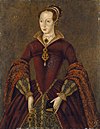 |
October 1537 Bradgate Park daughter of Henry Grey, 1st Duke of Suffolk and Lady Frances Brandon[64] |
Lord Guildford Dudley The Strand 21 May 1553 no children[65] |
12 February 1554 Tower of London aged 16 (beheaded)[64] |
| Mary I (Bloody Mary) 19 July 1553–1558[63] |
 |
18 February 1516 Greenwich Palace daughter of Henry VIII and Catherine of Aragon[63] |
Philip II of Spain Winchester Cathedral 25 July 1554 no children[63] |
17 November 1558 St. James's Palace aged 42[63] |
| Elizabeth I (The Virgin Queen) 17 November 1558–1603[63] |
 |
7 September 1533 Greenwich Palace daughter of Henry VIII and Anne Boleyn[63] |
unmarried | 24 March 1603 Richmond Palace aged 69[63] |
House of Stuart
Following the death of Elizabeth I in 1603 without issue, the Scottish king, James VI, succeeded to the English throne as James I in what became known as the Union of the Crowns. James was descended from the Tudors through his great-grandmother, Margaret Tudor, the eldest daughter of Henry VII. In 1604 he adopted the title King of Great Britain, although the two kingdoms remained separate.
| Name | Portrait | Birth | Marriage(s) | Death |
|---|---|---|---|---|
| James I 24 March 1603–1625[66] |
 |
19 June 1566 Edinburgh Castle son of Henry Stuart, Lord Darnley and Mary, Queen of Scots[66] |
Anne of Denmark Oslo 23 November 1589 seven children[66] |
27 March 1625 Theobalds House aged 58[66] |
| Charles I (Saint Charles the Martyr) 27 March 1625–1649[67] |
 |
19 November 1600 Dunfermline Palace son of James I and Anne of Denmark[67] |
Henrietta Maria of France St Augustine's Abbey 13 June 1625 nine children[67] |
30 January 1649 Whitehall Palace aged 48 (beheaded)[67] |
Commonwealth
There was no reigning monarch between the execution of Charles I in 1649 and the Restoration of Charles II in 1660. Despite this, from 1653 the following individuals held power as Lords Protector, during the period known as the Protectorate.
| Name | Portrait | Birth | Marriage(s) | Death |
|---|---|---|---|---|
| Oliver Cromwell (Old Ironsides) 16 December 1653–1658[68] |
 |
25 April 1599 Huntingdon[68] son of Robert Cromwell and Elizabeth Stewart[69] |
Elizabeth Bourchier St Giles[70] 22 August 1620 nine children[68] |
3 September 1658 Whitehall aged 59[68] |
| Richard Cromwell (Tumbledown Dick) 3 September 1658 – 7 May 1659[71] |
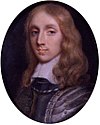 |
4 October 1626 Huntingdon son of Oliver Cromwell and Elizabeth Bourchier[71] |
Dorothy Maijor May 1649 no children[71] |
12 July 1712 Cheshunt aged 85[72] |
House of Stuart (restored)
Although the monarchy was restored in 1660, no stable settlement proved possible until the Glorious Revolution of 1688, when parliament finally asserted the right to choose whomsoever it pleased as monarch.
| Name | Portrait | Birth | Marriage(s) | Death |
|---|---|---|---|---|
| Charles II 1660-1685[73] Royalists dated his reign from 1649 |
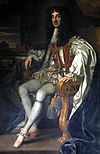 |
29 May 1630 St. James's Palace son of Charles I and Henrietta Maria of France[74] |
Catherine of Braganza Portsmouth 21 May 1662 three children (none survived infancy)[74] |
6 February 1685 Whitehall Palace aged 54[74] |
| James II 6 February 1685 – 23 December 1688[75] |
 |
14 October 1633 St. James's Palace son of Charles I and Henrietta Maria of France[75] |
(1) Anne Hyde The Strand 3 September 1660 eight children (2) Mary of Modena |
16 September 1701 Château de Saint-Germain-en-Laye aged 67[75] |
| William III of Orange (Willem van Oranje) 13 February 1689–1702[76] |
 |
4 November 1650 The Hague son of William II, Prince of Orange and Mary Stuart[77] |
St. James's Palace 4 November 1677 three children (none survived infancy)[76] |
8 March 1702 Kensington Palace aged 51[76] |
| Mary II 13 February 1689–1694[75] |
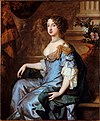 |
30 April 1662 St. James's Palace daughter of James II and Anne Hyde[75] |
28 December 1694 Kensington Palace aged 32[75] | |
| Anne 8 March 1702-1707[78] Great Britain 1 May 1707-1714 |
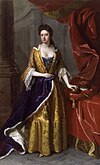 |
6 February 1665 St. James's Palace daughter of James II and Anne Hyde[79] |
George of Denmark St. James's Palace 28 July 1683 17 children[79] |
1 August 1714 Kensington Palace aged 49[79] |
Timeline of English Monarchs

Acts of Union
The Acts of Union were a pair of Parliamentary Acts passed during 1706 and 1707 by the Parliament of England and the Parliament of Scotland to put into effect the terms of the Treaty of Union that had been agreed on July 22, 1706, following negotiation between commissioners representing the parliaments of the two countries. The Acts joined the Kingdom of England and the Kingdom of Scotland (previously separate states, with separate legislatures but with the same monarch) into a single United Kingdom of Great Britain.[80]
The two countries had shared a monarch for about 100 years (since the Union of the Crowns in 1603, when King James VI of Scotland inherited the English throne from his first cousin twice removed, Queen Elizabeth I). Although described as a Union of Crowns, until 1707 there were in fact two separate Crowns resting on the same head. There had been three attempts in 1606, 1667, and 1689 to unite the two countries by Acts of Parliament, but it was not until the early 18th century that the idea had the will of both political establishments behind them, albeit for rather different reasons.
Titles
The standard title for all monarchs from Alfred the Great until the time of King John was Rex Anglorum (King of the English). In addition, many of the pre-Norman kings assumed extra titles, as follows:
- Alfred the Great: Rex Angulsaxonum (King of the Anglosaxons) and Rex Anglorum et Saxonum (King of the Angles and Saxons)
- Athelstan: Rex Anglorum per omnipatrantis dexteram totius Bryttaniæ regni solio sublimatus
- Edmund the Magnificent: Rex Britanniae and Rex Anglorum caeterarumque gentium gobernator et rector
- Edred: Regis qui regimina regnorum Angulsaxna, Norþhymbra, Paganorum, Brettonumque
- Edwy the Fair: Rex nutu Dei Angulsæxna et Northanhumbrorum imperator paganorum gubernator Breotonumque propugnator
- Edgar the Peaceable: Totius Albionis finitimorumque regum basileus
- Canute: Rex Anglorum totiusque Brittannice orbis gubernator et rector and Brytannie totius Anglorum monarchus
In the Norman period Rex Anglorum remained standard, with occasional use of Rex Anglie ("King of England"). Matilda styled herself Domina Anglorum ("Lady of the English").
From the time of King John onwards all other titles were eschewed in favour of Rex Anglie, or Regina Anglie ("Queen of England") if female.
In 1604 James I, who had inherited the English throne the previous year, adopted the title (now usually rendered in English rather than Latin) King of Great Britain. The English and Scottish parliaments, however, did not recognise this title until the Acts of Union of 1707 under Queen Anne (who was of course Queen of Great Britain rather than king).[81]
Notes
- ^ Keynes, Simon (1999), "Offa", in Lapidge, Michael (ed.), The Blackwell Encyclopedia of Anglo-Saxon England, Oxford, pp. 301–341, ISBN 0-631-22492-0
{{citation}}: Unknown parameter|publisher-=ignored (help)CS1 maint: location missing publisher (link) "The notion that Offa claimed to be 'king of the English', or 'king of the whole country of England', has been shown to depend, however, on charters forged in the tenth century. In his own day he was 'king of the Mercians', and proud enough to be so." (p. 341) Wormald, Patrick (1982), "The Age of Offa and Alcuin", in Campbell, James (ed.), The Anglo-Saxons, London: Phaidon, pp. 101–128, ISBN 0-14-0143950-5{{citation}}: Check|isbn=value: length (help) "Charlemagne, moreover, saw England as if it were ruled by two kings only; Aethelred ruling Northumbria, and Offa everything to the south." (p. 101) - ^ a b The Earliest English Kings, D.P. Kirby
- ^ a b c d e Burke's Peerage & Gentry URL last accessed 7 September 2007.
- ^ a b c d "thePeerage.com - Æthelbald, King of Wessex and others". Retrieved 2007-10-24.
- ^ "King Egbert". Retrieved 2007-10-24.
- ^ a b Alfred (the Great) @ Archontology.org. URL last accessed 15 March 2007.
- ^ Catholic Encyclopedia: Alfred the Great. URL last accessed 14 March 2007.
- ^ Alfred the Great. URL last accessed 14 March 2007.
- ^ a b EADWEARD (Edward the Elder) @ Archontology.org. URL last accessed on 15 March 2007.
- ^ There are various references listing Edward the Elder's birth as sometime in the 870s, being the second child of a marriage of 868. There are no sources listing his birth as after 877. Anglo-Saxons.net : Edward the Elder. URL last accessed on 15 March 2007.
- ^ English Monarchs - Kings and Queens of England - Edward the Elder. URL last accessed on 21 January 2007.
- ^ a b c Aethelstan @ Archontology.org. URL last accessed 15 March 2007.
- ^ EBK: Aethelstan, King of the English. URL last accessed 15 March 2007.
- ^ a b c EADMUND (Edmund) @ Archontology.org. URL last accessed 17 March 2007.
- ^ English Monarchs - Kings and Queens of England - Edmund the Elder. URL last accessed 17 March2007.
- ^ EADRED (Edred) @ Archontology.org. URL last accessed 17 March 2007.
- ^ a b EBK: Edred, King of England. URL last accessed 17 March 2007.
- ^ BritRoyals - King Edred. URL last accessed 17 March 2007.
- ^ a b c EADWIG (Edwy) @ Archontology.org. URL last accessed 17 March 2007.
- ^ Catholic Encyclopedia: Edwy. URL last accessed 17 March 2007.
- ^ EADGAR (Edgar the Peacemaker) @ Archontology.org. URL last accessed 17 March 2007.
- ^ a b EBK: Edgar the Peacemaker, King of England. URL last accessed 17 March 2007.
- ^ The Atheling. URL last accessed 17 March 2007.
- ^ a b EADWEARD (Edward the Martyr) @ Archontology.org. URL last accessed 17 March 2007.
- ^ EBK: Edward the Martyr, King of England. URL last accessed 17 March 2007.
- ^ a b Ethelred the Unready was forced to go into exile in the summer of 1013, following Danish attacks, but was invited back following Sweyn Forkbeard's death. AETHELRED (the Unready) @ Archontology.org. URL last accessed 17 March 2007
- ^ Schoolnet Spartacus: Ethelred. URL last accessed 17 March 2007
- ^ English Monarchs - Kings and Queens of England - Ethelred II, the Redeless. URL last accessed 17 March 2007
- ^ a b c EADMUND (Edmund the Ironside) @ Archontology.org. URL last accessed 17 March 2007
- ^ a b English Monarchs - Kings and Queens of England - Edmund Ironside. URL last accessed 17 March 2007
- ^ "English Monarchs". Retrieved 2007-10-27.
- ^ "Sweyn (Forkbeard) - Archontology.org". Retrieved 2007-10-27.
- ^ a b c "thePeerage.com - Person Page 10242". Retrieved 2007-10-27.
- ^ a b c d CNUT (Canute) @ Archontology.org. URL last accessed 21 March 2007.
- ^ a b c Harold was only recognised as king north of the River Thames until 1037, after which he was recognised as king of all England. "Harold (Harefoot) - Archontology.org". Retrieved 2007-10-27.
- ^ a b c "thePeerage.com - Person Page 10220". Retrieved 2007-10-27.
- ^ "Harthacnut - Archontology.org". Retrieved 2007-10-28.
- ^ a b c d e f g h "thePeerage.com - Person Page 10218". Retrieved 2007-10-26.
- ^ a b After reigning for approximately 9 weeks, Edgar the Atheling submitted to William the Conqueror, who had gained control of the area to the south and immediate west of London. "Eadgar (the Ætheling) - Archontology.org". Retrieved 2007-10-26.
- ^ a b "thePeerage.com - Person Page 9". Retrieved 2007-10-26.
- ^ a b c d e f g "thePeerage.com - Person Page 10203". Retrieved 2007-10-25.
- ^ a b c d e f g "thePeerage.com - Person Page 10204". Retrieved 2007-10-25.
- ^ "STEPHEN (of Blois) - Archontology.org". Retrieved 2007-10-25.
- ^ a b Matilda ruled at the same time as Stephen, but her reign was disputed. "thePeerage.com - Person Page 10204". Retrieved 2007-10-27.
- ^ "MATILDA (the Empress) - Archontology.org". Retrieved 2007-10-27.
- ^ a b c d e f g h "thePeerage.com - Person Page 10202". Retrieved 2007-10-25.
- ^ a b c d "thePeerage.com - Person Page 10201". Retrieved 2007-10-25.
- ^ a b c d "thePeerage.com - Person Page 10193". Retrieved 2007-10-25.
- ^ a b c d "thePeerage.com - Person Page 10191". Retrieved 2007-10-25.
- ^ a b c d Edward II was officially deposed by Parliament on 25 January 1327, having been imprisoned on 16 November 1326. "thePeerage.com - Person Page 10094". Retrieved 2007-10-25.
- ^ a b c d "thePeerage.com - Person Page 10188". Retrieved 2007-10-25.
- ^ a b c d Richard II was deposed, and became a prisoner of Henry Bolingbroke, who usurped the throne from the prior claims of the issue of his father John of Gaunt. "thePeerage.com - Person Page 10206". Retrieved 2007-10-25.
- ^ a b c d e f g "thePeerage.com - Person Page 10187". Retrieved 2007-10-25.
- ^ "HENRY IV - Archontology.org". Retrieved 2007-10-25.
- ^ a b c d e f g h Edward IV usurped the throne in 1461 after years of civil war. Henry VI was restored for about five months in 1470 before being deposed again permanently. "thePeerage.com - Person Page 10186". Retrieved 2007-10-25.
- ^ a b c d e f g h Edward was briefly deposed during his reign by Henry VI. "thePeerage.com - Person Page 10164". Retrieved 2007-10-25.
- ^ a b Edward V was deposed by Richard III, who usurped the throne on the grounds that Edward was illegitimate. "EDWARD V - Archontology.org". Retrieved 2007-10-25.
- ^ "thePeerage.com - Person Page 10165". Retrieved 2007-10-25.
- ^ "RICHARD III - Archontology.org". Retrieved 2007-10-25.
- ^ a b c "thePeerage.com - Person Page 10163". Retrieved 2007-10-25.
- ^ a b c d "thePeerage.com - Person Page 10142". Retrieved 2007-10-25.
- ^ a b c "thePeerage.com - Person Page 10148". Retrieved 2007-10-25.
- ^ a b c d e f g h i j "thePeerage.com - Person Page 10150". Retrieved 2007-10-25.
- ^ a b c Jane was deposed in favour of Mary Tudor. "thePeerage.com - Person Page 10152". Retrieved 2007-10-25.
- ^ "Lady Jane Grey: Marriage". Retrieved 2007-10-25.
- ^ a b c d "thePeerage.com - Person Page 10137". Retrieved 2007-10-25.
- ^ a b c d "thePeerage.com - Person Page 10138". Retrieved 2007-10-25.
- ^ a b c d "Oliver Cromwell 1599-1658". Retrieved 2007-10-25.
- ^ "Oliver Cromwell - Faq 1". Retrieved 2007-10-25.
- ^ "New Page 1". Retrieved 2007-10-25.
- ^ a b c "Richard Cromwell, Lord Protector, 1626-1712". Retrieved 2007-10-25.
- ^ "CROMWELL, Richard - Archontology.org". Retrieved 2007-10-25.
- ^ http://www.britannia.com/history/monarchs/mon49.html
- ^ a b c "thePeerage.com - Person Page 10139". Retrieved 2008-11-30.
- ^ a b c d e f g "thePeerage.com - Person Page 10136". Retrieved 2007-10-25.
- ^ a b c "thePeerage.com - Person Page 10141". Retrieved 2007-10-25.
- ^ "WILLIAM III - Archontology.org". Retrieved 2007-10-25.
- ^ "Anne (England) - Archontology.org". Retrieved 2007-10-25.
- ^ a b c "thePeerage.com - Person Page 10134". Retrieved 2007-10-25.
- ^ Welcome parliament.uk, accessed 7 October, 2008
- ^ After the personal union of the three crowns, James was the first to style himself King of Great Britain, but the title was rejected by the English Parliament and had no basis in law. The Parliament of Scotland also opposed it. Croft, p67; Wilson, pp249-252. See also the early history of the Union Flag.
See also
- List of British monarchs
- List of monarchs in the British Isles
- List of Scottish monarchs
- Line of succession to the British Throne (a list of people)
- List of English consorts
- Succession to the British throne (historical overview and current rules)
- Alternate successions of the English crown
- List of monarchs of the British Isles by cause of death
- Demise of the Crown
- Mnemonic verse of monarchs in England
